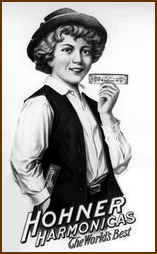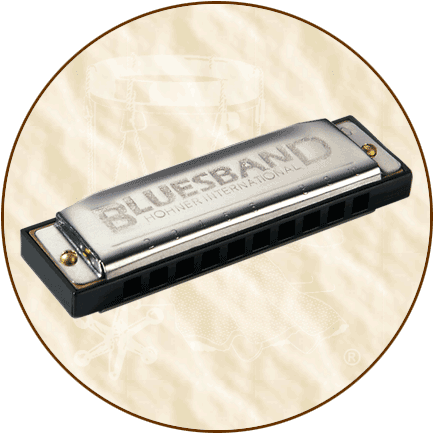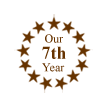.
Continued from product description on
Folk Instruments' Page Two...
Historical
Background: The harmonica is a free-reed wind instrument
that has multiple, variably tuned reeds. The reeds are made from
either bronze or brass. Each reed is secured at one end over
an airway slot. As air passes through the slot, the reed vibrates
and interrupts the air stream to make a specifically pitched
sound. The harmonica is also known as a "mouth organ,"
"french harp" (or simply "harp"), and "Mississippi
saxophone."
As a free-reed instrument, the harmonica belongs to the same
family of musical instruments as reed organs, accordions, and
melodicas. Unlike its other family members that have keyboards,
the mouth organ uses the player's lips and tongue to select one
or more slots (or holes). The holes are usually arranged in a
linear manner on the mouthpiece. Types of harmonicas include
the diatonic harmonica (10 holes, 19 notes, and 3 octaves), special-tuned
harmonicas, the 14-hole diatonic harmonica, the chromatic harmonica,
the bass harmonica, the cord harmonica (with 48 chords), the
Tremolo harmonica, the octave harmonica, and toy harmonicas.
The origin of the harmonica is generally accepted by musicologists
to come from a Chinese wind instrument called a "sheng"
(or "cheng") circa 3000 B.C. Despite the fact that
these two instruments' shapes differ greatly, both use a free-reed
mechanism in a very similar manner. In 1636, Marin Mersànne
introduced Europe to the sheng through his letters describing
it as "an Asian free-reed wind instrument." In 1776,
French Jesuit missionary Pare Amiot shipped several shengs from
China to Paris, France. By the 1780s, European instrument makers
were experimenting with free-reeds.
In 1816, a free-reeded keyboard instrument called a "terpodion"
was introduced by Johann Buschmannn, a German organ builder.
This instrument would later become the predecessor to both the
harmonica and the harmonium. His sixteen-year-old son, Christian
Friedrich Buschmann, would invent and register in 1821 for the
first European patent of a free-reeded mouth organ, which he
called the "aura," or "mundaeoline."
In 1825, the first 20-note (10-hole), blow-draw, free reed-mouth
organ was developed by a Bohemian named Richter (first name unknown).
Two years later, a clock maker in Trossingen, Germany, started
making harmonicas with his cousin, Christian Weiss. In two more
years, 1829, the first massproduction of harmonicas began in
Vienna, Austria.
 A
fellow clock maker in Trossingen, Mathias Hohner, visited the
harmonica shop of Messner and Weiss in 1857. Shortly thereafter,
he (along with family members and one or two workers) began to
make harmonicas in his kitchen. Their first year's production
was 700 harmonicas. By 1867, the M. Hohner Company was producing
22,000 harmonicas a year. Most of the world's harmonicas made
today are by the M. Hohner Company in a factory that is still
located in Trossingen, Germany.
A
fellow clock maker in Trossingen, Mathias Hohner, visited the
harmonica shop of Messner and Weiss in 1857. Shortly thereafter,
he (along with family members and one or two workers) began to
make harmonicas in his kitchen. Their first year's production
was 700 harmonicas. By 1867, the M. Hohner Company was producing
22,000 harmonicas a year. Most of the world's harmonicas made
today are by the M. Hohner Company in a factory that is still
located in Trossingen, Germany.
In 1878, Julius Berthold developed a machine to stamp out
metal reeds, thus ending the need to make reeds by hand. The
following year, the Richter-note configuration was introduced
to 10-hole harmonicas. This would later become the standard configuration
for diatonic harmonicas. The American Depression of 1893 caused
the M. Hohner Company to stop exporting harmonicas to the U.S.
and start marketing mouth organs to other countries. This decision
ultimately expanded the range of the harmonica's influence in
the world.
Three years later (1896), the M. Hohner Company introduced
their revolutionary Marine Band model harmonica. Its raised,
ornate metal covers and superb construction features would eventually
make it the world's top-selling harmonica.
Use of the harmonica, however, did not become widespread in
Europe and was considered a very limited "standalone instrument."
Around 1900, a relative of Hohner started exporting harmonicas
to the United States. There they soon became a very popular musical
instrument because of their compact size and due to the fact
"harps" (as Americans now called them) were relatively
easy to learn to play.
The earliest music recordings of harmonicas occurred during
the 1920s in the U.S. These first recordings were primarily "race
records" that were marketed to southern African-Americans.
An early solo recording artist during this period was DeFord
Bailey who also "cut" the first country music records
in Nashville, Tennessee. Other harp recording artists were often
accompanied by a guitarist and they include Walter Horton, Hammie
Nixon, and Sonny Terry. Later, the harmonica was incorporated
into novelty acts called "jug bands," such as the famous
Memphis Jug Band. During this decade, harmonica bands sprung
up throughout the U.S. and became "the rage in Vaudeville."
The 1920s saw other developments for the harmonica. Philadelphian
philanthropist, Albert Hoxie, organized harmonica contests and
bands (complete with marching uniforms). His generous efforts
spawned a national craze for harmonica bands. In 1924, the M.
Hohner Company introduced the chromatic harmonica and followed
up by creating bass, chord, and polyphonia models to satisfy
the needs of harmonica bands.
Despite the harmonica's popularity in the U.S., the instrument
was regarded by many to be just a toy and associated with "poor
folks" during the 1930s. It was during the Great Depression
that harmonicists started to experiment and develop new techniques.
These innovations include tongue blocking, hand effects, and
-- perhaps the greatest innovation of all -- the 2nd position,
or "cross harp."
The Great Depression did not, however, stymy the harmonica's
growth in popularity. Harmonica bands were still the rage in
the U.S. Many public schools were now making harmonica instruction
part of their standard curriculum. Even Hollywood started putting
harmonica bands in their movies. It was during this decade that
the first major soloist on the harmonica emerged, Larry Adler,
who played both Classical and Jazz pieces. But by the end of
the 1930s, the jug band craze was fading away (at least until
the Folk revival in the 1960s).
Unfortunately, World War II temporarily stopped the import
of harmonicas from Germany to the U.S. This war also caused many
harmonica bands to dissolve as players enlisted in the armed
forces. But there was also a labor shortage in the northern manufacturing
states that enticed hundreds of southern Blues harmonica players
to migrate north for work.
It is for this reason that the harmonica and its southern-style
of music found "homes" in the northern U.S. -- particularly
in Chicago, Detroit, New York City, and St. Louis, where many
black migrants and blues musicians relocated. It was in these
cities (and mostly in Chicago) that the harmonica and its Blues
and Jazz music began a tremendous evolution. This musical evolution
came about through "electric amplification" -- first
the guitar, then the harmonica, followed by the bass, vocals,
and other instruments.
There have been many notable blues harp players in America,
but two stand out as pioneers of the blues harmonica -- and both
used the stage name, "Sonny Boy Williamson"! One was
John Lee Williamson (1899-1948) and the other was Alex Ford Miller
(1914-1965). John Lee's first recording, "Good Morning,
School Girl," became a hit in 1937. His style influenced
many Blues performers, including Billy Boy Arnold, Sonny Terry,
and a young Muddy Waters. Miller, on the other hand, became such
a virtuoso that his peers nicknamed him the "King of the
Harmonicas." Over the years, there have been many, many
Blues and Jazz harmonicists who recorded and received deserving
critical acclaim.
The 1950s saw the virtual disappearance of harmonica bands.
However, harmonica trios grew in popularity, thanks to the success
of The Harmonicats. During this decade, electric or amplified
harmonicas dominated the Chicago Blues scene and was led by Little
Walter. Legend has it that Little Walter plugged his harmonica
microphone directly into a guitar amplifier while recording with
Muddy Waters, thus becoming the first to record a Chicago-style
amplified harmonica. This overdrove the sound and created an
entirely new style of harmonica playing. Despite this innovation,
guitar players began and continued to dominate the American music
scene while harmonicas basically disappeared for awhile.
English merchant seamen would often bring recordings of American
Rock and Blues music home with them on their return trips. Many
an English-seaport teenager would eventually learn about the
Blues and "Rock n' Roll" from these American recordings.
One notable example is a Liverpool adolescent by the name of
John Lennon. However, it was actually Blues fans such as Cyril
Davies and John Mayall that really laid the foundation for the
"British Invasion" of America in the 1960s. It was
also during the 1950s that Jean "Toots" Thielemans
became a major instrumentalist in Jazz with his harmonica.
Bob Dylan inspired thousands of musicians to explore with
the harmonica during the Folk music craze of the 1960s. He also
renewed interest in jug bands. And, of course, the British Invasion
of the American music scene was spearheaded by The Beatles in
1964. Not only did Lennon feature a harmonica in his songs, but
several other bands did so as well, such as The Rolling Stones
and The Yardbirds. By the late 1960s, a rebirth in popularity
for the harmonica in Blues was led by Paul Butterfield, Charlie
Musselwhite, and Corky Siegel of Chicago, Illinois.
The harmonica experienced yet another decline in popularity
during the 1970s as guitarists continued to dominate both Blues
and Rock music while Country music stagnated in an "overproduced
Nashville sound." Only The J. Geils Band and its harmonica
player, Magic Dick, stands out for Rock harmonica during this
period. As the decade wore on, Blues music in general also suffered
a decline in popularity, but not for long!
Like a yo-yo, the popularity for and interest in the Blues
harmonica bounces back (once again) in the 1980s, thanks to a
couple of comedians on the television show "Saturday Night
Live." John Belushi and Dan Akroyd's love for Blues music
inspired them to create a musical skit in the late 1970s called
"The Blues Brothers" (and, in 1980, a feature film).
It is also during this decade that the Cham-Ber Huang and Lee
Oskar Harmonica Companies introduced harmonica design innovations,
such as new tunings and replaceable reed plates.
In the 1990s, Sugar Blue, Howard Levy, and John Popper of
the band Blues Traveler pushed the limits of harmonica playing
in Blues, Jazz, and Rock music. Country music also sparked renewed
interest in the harmonica when it returned to its traditional
music.
Historical Folk Toys is pleased to continue a long tradition
by offering our Harmonica in C (5101), which is ideal for beginners.
Fun
Fact: By 1887, the M. Hohner Company was producing 1 million
harmonicas annually. Ten years later, they would be making 3
million harmonicas a year. And, in 1911, the company produced
8 million harmonicas. Sometime during the year 1986, they produced
their billionth harmonica! (This is quite an accomplishment for
a business that was started in a family's kitchen!)
Fun
Fact: The Harmonicats' recording of "Peg O' My Heart"
was the best-selling record of 1947. It would later become one
of the all-time, best-selling singles with over 20 million copies
sold! This record's success also convinced the Musician's Union
to change the harmonica's classification from "toy"
to "legitimate instrument," thus allowing harmonicists
to join the union.
Fun
Fact: The Society for the Preservation and Advancement
of the Harmonica (SPAH) was founded in Detroit, Michigan, in
1962.
Fun
Fact: The harmonica became the first musical instrument
to be played in outer space on December 16, 1965, when astronaut
Wally Schirra played "Jingle Bells" on a Hohner Little
Lady model -- that he smuggled aboard Gemini 4!













